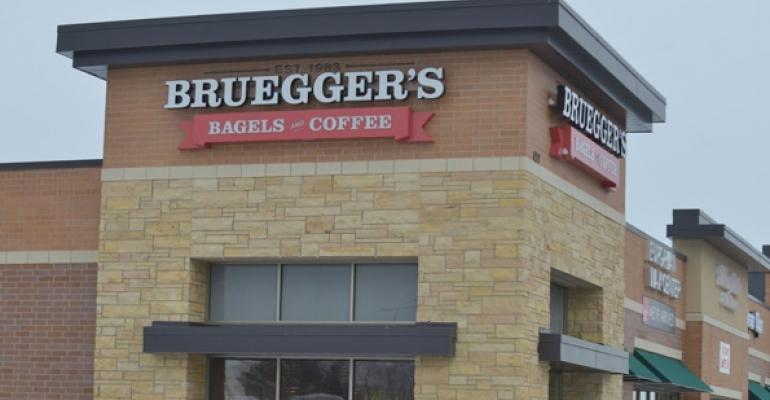Bruegger’s Enterprises Inc. has pulled the wraps off a new prototype unit in Woodbury, Minn., that highlights a “bake theater” and an industrial-influenced look.
The 302-unit division of Le Duff America Inc. opened the unit in a suburb east of St. Paul, Minn., on Jan. 22.
MULTIMEDIA
A look at Bruegger's new prototype
Watch a video tour of Bruegger's new prototype
RELATED
• Bruegger's Bagels names Miguel Fernandez COO
• Bruegger’s, Caribou to co-brand in growth effort
Allison Russell, Le Duff America’s Dallas-based manager of design and concept, said the Woodbury location is the brand’s flagship design.
“This was developed as a prototype so that we can incorporate this going forward,” Russell said. “We have another new bakery that we have planned for this year, and we are taking some of these aspects and retroactively going into some of the renovations. We want to make a really consistent brand statement throughout the portfolio of assets.”
The 2,200-square-foot bakery features an open kitchen separated from in-store patrons and the parking lot by plate glass windows, which offer views of the unit’s traditional kettle for boiling bagels and oven.
The new location also features community tables and bar seating, and sports a revised logo, team uniforms and packaging. The menu will include new breakfast and lunch categories, with salmon in salads and sandwiches.
One wall will display work by the winner of the “Bruegger’s Bagels $10,000 Artist Challenge,” which through March 31 is seeking submissions from area artists to be featured prominently in the location.
The contest helps get customers to participate in the design, which is part of the brand’s focus, said Judy Kadylak, Bruegger’s director of marketing.
“We are a neighborhood gathering place, and the new prototype is designed to accentuate our bagel tradition while also celebrating new ideas and the creative spark,” Kadylak said.
Bruegger’s, headquartered in Burlington, Vt., is owned by Le Duff America, which also owns the Mimi’s Café, La Madeleine and Brioche Dorée brands. Le Duff America is owned by Paris, France-based Groupe Le Duff.
 Q&A with Russell
Q&A with Russell
What are the biggest changes to the prototype?
Some of the main changes have to do with the ‘bake theater,’ presenting the baking right up front to the customer to really reinforce the authentic baking method that we have. That’s very specialized to a New York-style bagel that Bruegger’s makes. Having the kettle and the oven right up and making that a real experience for the guest — seeing the bagels boiled and then baked — that is something different from any of the other locations.
Where were the kettle and oven located prior?
Previously it was kind of in the back of the bakery. It had a smaller viewing window. It was viewable but not theatrical.
How does this unit compare in size to other units?
It’s comparable but a little on the small side. It may be a couple hundred square feet smaller than some of our typical units. That’s strictly based on the location on the real estate in the right development.
What are the advantages of having the bake theater open to the outside of the unit as well as inside?
As you drive up in the parking lot you can see in the front windows. You can see the kettle. You can see the baker. You can see the ovens. Right when you come in the front you are greeted with a marketing credenza and you turn immediately in the queue to see the bake window. You can’t pass it without seeing the bake theater.
Is the community seating new?
Previously it was more along the lines of a fast-casual-type atmosphere with booths and tables. This is much more to reinforce the New York styling of having community groupings where you share seating with others, rather than everyone having a special little place to themselves.
The big community table is on casters and movable?
It is, but part of that is for good cleaning practices. It goes back to reinforcing the industrial bakery heritage, which typically has stainless tables and carts on casters. Because of its size it’s easier to move around for cleaning. It has a bit of flair because the casters are red.
How about the finishes and colors?
We used quilted stainless and chrome racks. All of that is displayed proudly. We have the exposed brick to add texture and a vintage aspect to it. It uses authentic materials like hot-rolled steel. We don’t use the fast-casual plastic laminates. One of the artwork pieces is ‘Bakery, No Fakery.’ We’ve taken that to the nth degree. The lighting fixtures are authentic metal pieces. Some of the fixtures over the bar seating are actually acetylene-tank top caps.
How about the new espresso bar?
Specialty coffee has been available [in other units] but it wasn’t presented in the same way. This has a full-time expert barista who serves specialty coffees from a special espresso machine. Going forward, that is going to be a focus for Bruegger’s, to be able to elevate the brand with espresso drinks.
What are the advantages of the Artist Challenge?
We’re focused on elevating the experience of the customer. The perception of the brand is reality. Instead of having some corporate-advertising-type artwork, having the customer develop the artwork was really important to us. It is more about the community and the participation. That will be a focal point for us. The contest ends March 31 and it will be up within the 30 days. What’s there now is a calling for artwork with the message, ‘Our bricks, your canvas.’
Contact Ron Ruggless at [email protected].
Follow him on Twitter: @RonRuggless






